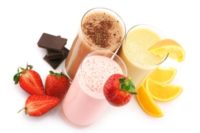First there are the cost-saving ingredients that are helping dairy processors stay afloat during struggling economic times. Then there’s the category of health and wellness, with many of these value-added ingredients actually increasing production costs. But because they help marketers create a point of differentiation in a highly competitive marketplace, when proper promotion and education is part of the product, costs can be readily recouped through a premium shelf tag.
Powerhouse additions
According to the 2011 Functional Foods/Foods for Health Consumer Trending Survey conducted by Washington, D.C.-based International Food Information Council (IFIC), the majority of Americans (95%) believe they have some control over their health and that food and nutrition play the most important role in maintaining and improving their overall health. Further, 87% of the 1,000 consumers who participated in a web-based survey this past spring agree with the concept of functional foods, which are defined as those that may provide benefits beyond basic nutrition.
Respondents identified cardiovascular disease, which includes heart disease, heart attack, high blood pressure, high cholesterol and stroke, as their No. 1 health concern. The good news for dairy processors is that there are a multitude of functional ingredients — including omega-3 fatty acids, fiber and phytosterols — available to them for enhancing dairy products and positioning them as heart healthy.
Cardiovascular disease is followed by weight, then cancer. Healthy aging was a leading health concern of 19% of consumers. The good news, again, is that scientists are aggressively exploring food components and ingredients that address these concerns, with a growing number of suppliers offering dairy processors ingredient solutions for innovative product development.
The accompanying chart (page 78) lists functional food components or ingredients that apply to dairy foods. The data come from the IFIC study and indicate the number of consumers surveyed who are aware that a specific food component or ingredient has an associated health benefit.
Aware consumers further indicated if they are already consuming this component or ingredient for this benefit or if they plan to within the upcoming year. With this knowledge, ingredient suppliers and dairy processors can work together to offer consumers more of what they are looking for.
Looking at the data, it should not be surprising that consumers are most aware of the calcium and vitamin D connections to bone health and reduced risk of osteoporosis. After all, these benefits have been consistently communicated to consumers through numerous channels for many years.
The IFIC study shows that 92% of Americans know the calcium connection, while 90% also know the vitamin D connection. When those aware of these benefits were asked if they already consume foods with calcium, 58% said yes, and 37% plan to do so in the next year. For vitamin D, these figures are 55% and 41%, respectively. It’s no wonder that many processors are adding vitamin D to dairy products beyond the required fluid milk, as well as boosting calcium contents.
The next best-known functional food relationships involve protein. Specifically, 87% of consumers surveyed understand that protein, in general, supports overall health and well-being, while 86% are aware of the weight management connection. More than half of those aware of these connections say they are already eating the protein they need to reap these benefits, while almost all of the remaining consumers plan to increase their intake within the year.
What’s surprising with this data is how omega-3 fatty acids, specifically docosahexaenoic acid (DHA), trump fiber and its many functional benefits. It’s no wonder that omega-3s were the buzzword at the International Dairy Show in September. One supplier suggested that as the scientific community learns more about the benefits of DHA and reduced risk of heart disease, as well as DHA’s positive impact on cognitive function and other emerging health benefits, it would make sense to require all fluid milk to be fortified with DHA, along with vitamins A and D.
And Emily Alfano, director of marketing and new product development at Future Food Brands, Carrollton, Texas, says, “Consumer interest in omega-3 fatty acids continues to grow and is definitely a driver for product development at our company.”
Indeed, most dairy foods are a natural fit for the addition of omega-3 fatty acids, as their relatively short, refrigerated shelf life complements the stability of many of the omega-3 ingredients in the market. Dairy processors are well poised to give consumers what they want.
According to the IFIC survey, 85% of adults indicated that they are aware of the omega-3 and reduced risk of heart disease connection. And 73% know omega-3s have a positive influence on cognitive development, especially in children. When asked if they are consuming omega-3s for these various benefits, less than half currently are, and almost an equal amount plan to in the next 12 months.
Of all nutrients, fiber has the most associated health benefits. The No. 1 connection is fiber’s role in feeling full, with 85% of adults surveyed recognizing this benefit. Seventy-nine percent understand fiber’s role in digestive health. Less known, but not any less important, or less of an opportunity for marketers, is the connection between fiber and heart health, cancer and blood sugar levels.
The really impressive fact is that of those consumers aware of the benefits of consuming fiber, 60% or more are already getting fiber in their diet, and almost everyone else plans to get more fiber in their diet during the next year. Again, here is one of those great need-want opportunities for dairy processors. You can help consumers get more of the nutrients they want by adding functional ingredients such as fiber to product formulations.
Moving onto probiotics, it is notable that so many consumers claim to be aware of the connection between probiotics and digestive health — 81% of those surveyed. However, there must be some disconnect because not even half of the consumers who say they are aware of the connection between probiotics and a healthy digestive system say they are already consuming such products. The good news is there is interest in doing so, presenting yet another opportunity for dairy processors.
What’s important is that the product includes legitimate probiotic cultures in order to not challenge consumer confidence. This can be accomplished by using live microorganisms in quantities that have been clinically proven to have a specific health benefit. The studies should be performed in humans and published in peer-reviewed, reputable journals.
Cost optimization
Moving onto cutting costs, the dairy industry has long been known as one for low profit margins. Thus, ingredients that can help maintain product quality while saving money have become increasingly popular during the past few years and will continue to influence product development in the near future.
One of the product categories that ingredient suppliers have been working with is cottage cheese, as many believe that consumer interest in high-protein dairy foods will bring new users to this category and turn it around after years of decline.
A new cottage cheese stabilizer challenges the typical 45-55% dressing-to-curd ratio and allows manufacturers to reverse this ratio to 55% dressing and 45% curd without sacrificing product integrity or changing the production process. The net result of this new ingredient technology can help processors save millions of dollars every year, depending on their annual production output.
It is also now possible to have a faster vat turnover when making cottage cheese when a new phage-resistant culture is used that also provides for a faster, more consistent set time. This combination of attributes can increase curd yield, which translates to improved profits.
With gelatin costs continuing to climb (they have nearly doubled in the past year), many yogurt makers are looking for a cost-effective alternative that produces a product with the same smooth, creamy, melt-in-your mouth experience that gelatin provides. This is proving to be possible through a texturant based on a unique combination of pectin and starch.
Texturants can also be used to mimic milkfat in some applications. The net result not only reduces costs by replacing milkfat with less expensive ingredients, but there’s also an improvement in nutrition profile, as fat and calorie contents get lowered.
Finally, for those processors not in the Greek yogurt business, texturant suppliers offer solutions that yield a thicker, denser yogurt without having to invest in traditional straining equipment. This is possible by benchmarking the targeted texture, characterizing the sensory attributes and blending texturants until a prototype is produced with a similar mapping of attributes such as oral viscosity, mouthcoating, melt and degree of gel.
In conclusion, dairy foods formulators can expect to see more ingredient solutions that impact the value of dairy products, in terms of profitability and nutrition profile. It’s imperative that processors work closely with their suppliers and be specific about the objectives.
|
Ingredient Suppliers Are Talking About:
Ingredients Driving Flavored Milk Formulations |






